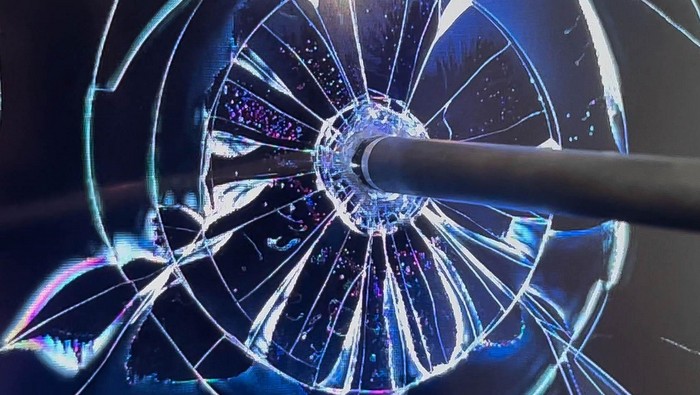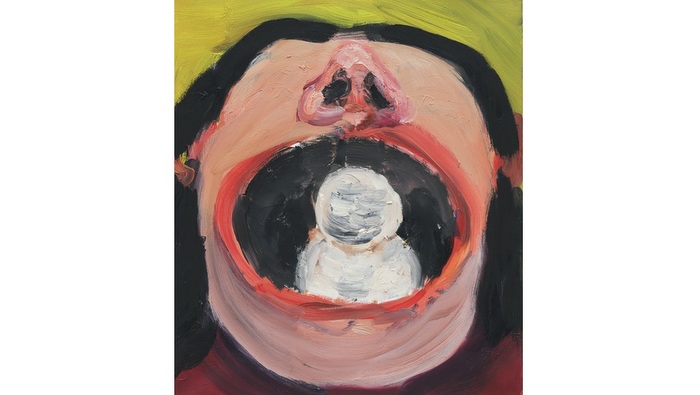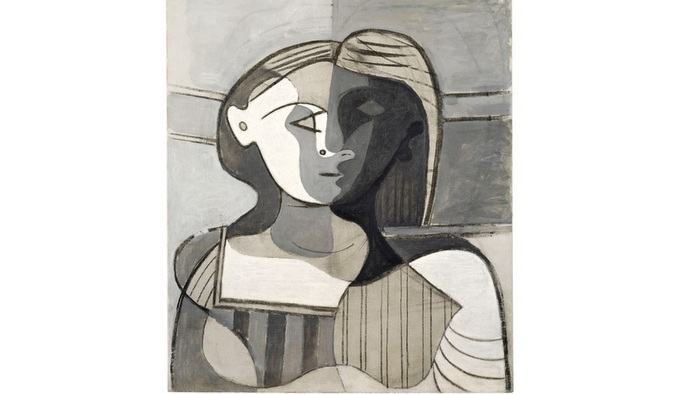The ancient Greek believed that Helios, the god of the sun, rode a fiery chariot through the sky, in this manner illuminating the world. However, when Helios let his son Phaeton lead the carriage, the inexperienced rider lost control over it, threatening to crash on earth and destroy the world. Zeus had to strike Helios' chariot, killing Phaeton by the same token. As is often the case, Greek mythology provides an accurate yet simple narration to apprehend man's relation to the world around him. Echoes of this story are found in Nicolas Grospierre's latest exhibition at Alarcon Criado: Heliosophia. Composed of two distinct yet interdependent parts, Heliosophia brings forward works which develop an ambiguous relation to the sun, and light in general, as a creative means, but also perhaps as a destructive agent.
The first set of works, Heliographia, are abstract geometric compositions which seem to have been drawn on large velvet canvases. What looks like a print is in fact the direct action of the sun over several months. During this time, lightproof caches were placed over the velvet, and periodically moved, the sun burning out the exposed parts. It is a kind of photography without paper, without film, without camera even, the sun being the sole creative power.
Heliopolis is a set of photographs of modernist buildings from different parts of the world, whose common denominator is that they all have been destroyed, each time for different and specific reasons. However, the prints are tricked. Their photographic process has purposefully not been fixed, in such a way that when shown to the public, i.e. when exposed to light, they begin to black out. Here the sun is a destructive force, erasing structures which have already been torn down.
However, and upon closer examination, things are not as simple as they seem. Both works provide canny examples of the paradox of creative destruction, i.e. when the symbolic capital of the destruction of an object is greater than its material value. One may indeed consider that the Heliographic compositions are in fact, from a technical point of view, the deterioration of an originally virgin piece of velvet. On the other hand, the Heliopolis photographs are probably more than a simple set of images. One may indeed venture that it is their very fragile nature, their self- destructive quality - that the more one looks at them, the more they become difficult to perceive - which provides a truly genuine artistic experience.
Ultimately, Heliosophia is therefore not only about the sun, but about the complex and intertwined relation between the creative and destructive processes at work in any manly work.
Biography:
Geneva, Switzerland, 1975.
Grospierre Nicolas lives and works in Poland. Is an artist who works and understands the extensive mode photography. Before focusing his career in the arts, formed at the Institut d’Etudes Politique de Paris and the London School of Economics. His work as a photographer has been so focused on documentaries and more conceptual works. The former have often explored the collective memory and hopes linked to modern architecture at a time, current , where utopias linked to it have been ginned .On the other hand, his photography has to emphasize conceptual puzzle games, while attractive and sensual displays images or facilities. Nicolas Grospierre has been awarded the Golden Lion at the 11th edition of the Venice Biennale (2008) for the exhibition Hotel Polonia in the Polish Pavilion, and has also received the Polityka Passport Award Artistic Residence at Stadtgalerie der Schedule,
Bern (2012), the Prize of the Ministry of Culture of the Republic of Poland (2009) and Graham Foundation of Chicago scholarship in 2014. His monograph, Open -Ended, has been published by Jovis Verlag (Berlin, 2013) and his work has been included Phaidon book in the New SHOOTING SPACE : ARCHITECTURE IN CONTEMPORARY PHOTOGRAPHY Elias Redstone and in Modern Forms. A Subjective Atlas of 20th-century Architecture,edit by Elias Redstone anda Alona Pardo. It has been part of individual and collective exhibitions in different parts of Europe and America: All Pales Before The Book en PhotoEspaña (Centro de Arte de Alcobendas, Madrid), Modern Forms. A Subjective Atlas of 20th-century Architecture, Architectural Association School of Architecture of London , La Memoria finalmente Arte in Polonia dal 1989-2015 in Galleria Civica di Modena (2016) Viewfinder in the Signum Foundation of Poznan and Lost in Architecture, Baltic Gallery of Contemporary Art, Słupsk in 2015, A glass shard in the eye (with Olga Mokrzycka) in BWA Warszawa Warsaw and The Oval Offices, Maison de la Photographie, Lille (2014), a project that exhibited in 2013 at the Presidential Palace of the Republic of Poland and the State Gallery of Art, Sopot, and elsewhere as Bunkier Sztuki in Krakow, Graham Foundation, Chicago , Raster Gallery, Warsaw, Signum Foundation of Venice, Artist ‘s House, Jerusalem, Ecco – Espacao Cultural Contemporaneo, Brasilia, Kunsthalle, Bratislava, National Art Museum of China, Beijing. His work is present in collections like National Museum in Warsaw, Polonia, Rubell Family Collection, Jan Michalski Foundation Switzerland, Coleccion Los Bragales, Coleccions DKV, Signum Foundation Collection, ARUP Collection, APT Collection,PAMM Miami, Jozami Collection and 21 Century Museum.
SOLO SHOW: HELIOSOPHIA
AUTHOR: NICOLAS GROSPIERRE
DATES: 29th September 2017 – 18th November 2017
OPENING NIGHT: Friday 29th September at 8:30 p.m.
Related Publications

Leo Pum presents HYPER LIKE at HYPER HOUSE
December 18, 2025
Aargauer Kunsthaus. Klodin Erb. Curtain falls dog calls
December 17, 2025











